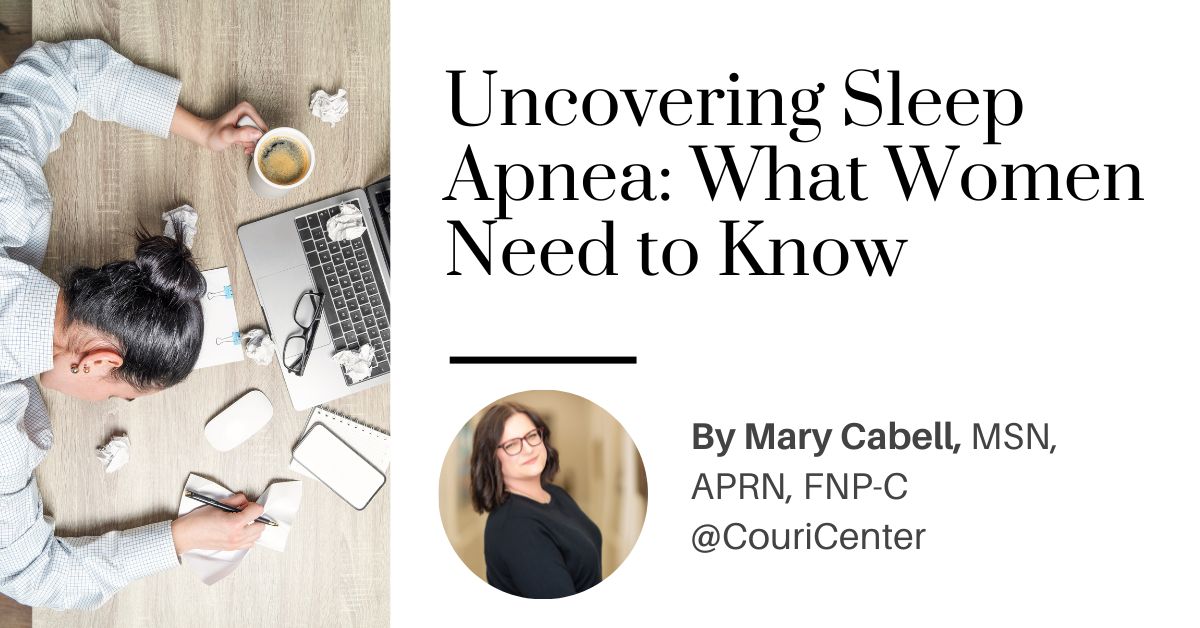
Summary
Struggling with poor sleep could be more than just a nuisance—it might be sleep apnea, a condition that affects many women but often goes undiagnosed. In her latest blog, Mary Cabell, MSN, APRN, FNP-C, sheds light on this common disorder, explaining how it disrupts breathing during sleep and can lead to serious health complications. She outlines key symptoms, such as daytime drowsiness and mood changes, and stresses the importance of proper screening and treatment. If you're experiencing signs of sleep apnea, it's crucial to consult your healthcare provider for a thorough evaluation and appropriate care.
I don’t think it’s any secret how important sleep is to our well-being. Not getting quality sleep can impact many aspects of our physical and mental health. A commonly undiagnosed yet common disorder among women is sleep apnea.
What is sleep apnea?
- Between 10% and 15% of women in the United States have obstructive sleep apnea (OSA). OSA is a sleep disorder commonly presenting as breathing that stops during sleep.
- Our bodies have a reflex that wakes us up and restarts our breathing, but this physiological response can cause other complications in addition to causing interrupted sleep.
What symptoms should I look for?
- Common symptoms of sleep apnea in women include daytime sleepiness, snoring, restless legs, frequent urination at night, insomnia, morning headaches, and mood changes, including feelings of depression or anxiety. It is important to note that you do not have to snore to have sleep apnea; gasping or choking may be common symptoms, too.
- There are some conditions that are gender-specific to consider when thinking about sleep apnea in women. Menopause, polycystic ovarian syndrome (PCOS), and pregnancy are all risk factors. As estrogen levels drop during menopause, the risk of developing sleep apnea can more than double. In fact, 20% of women develop sleep apnea in menopause. Sleep apnea is a common comorbidity for those diagnosed with PCOS, too.
- Other risk factors, regardless of gender, include obesity and neck circumference.
I have risk factors; now what?
- Healthcare providers can use different screening tools to determine the need for a sleep study; two common studies are the NoSAS and the STOP-Bang questionnaire. They assign point values to various risk factors for sleep apnea, such as neck circumference, obesity, snoring, age, gender, daytime tiredness, and observed apneas. Some studies have shown that these screening tools may not work as well for women, though, so it is important to have these discussions with your healthcare provider.
- If your healthcare provider determines you need a sleep study, also called polysomnography, this may either be done in a sleep center or at home with a kit and some professional guidance. Polysomnography monitors breathing patterns, vital signs, and activity while you sleep.
What if I am diagnosed?
If it is determined that you have sleep apnea, there are various treatments available. Determining how to treat sleep apnea will be based on the results of the sleep study in addition to other factors. Treatment options include continuous positive airway pressure (CPAP), oral appliances, implants, and other surgical options.
What happens if I go untreated?
Untreated sleep apnea can have many impacts on women’s health.
○ Cardiovascular symptoms such as high blood pressure, heart disease, stroke, and arrhythmias.
○ Diabetes
○ Depression, mood changes, poor decision making
○ Daytime sleepiness increases the risk of accidents
○ Decreased immunity
If you feel like you have symptoms consistent with sleep apnea, speak to your healthcare provider. We’re here to help.
Mary Cabell, MSN, APRN, FNP-C
Sources:
Bauters, F. A., Loof, S., Hertegonne, K. B., Chirinos, J. A., De Buyzere, M. L., & Rietzschel, E. R. (2020). Sex-specific sleep apnea screening questionnaires: closing the performance gap in women. Sleep Medicine, 67, 91–98. https://doi.org/10.1016/j.sleep.2019.10.023
Sleep Apnea Symptoms in Women. (2023, June 1). Sleep Foundation. https://www.sleepfoundation.org/sleep-apnea/sleep-apnea-symptoms-in-women
DISCLAIMER: THE INFORMATION PROVIDED ON THIS WEBSITE IS INTENDED FOR GENERAL INFORMATIONAL PURPOSES ONLY AND IS NOT INTENDED TO BE A SUBSTITUTE FOR PROFESSIONAL MEDICAL ADVICE, DIAGNOSIS, OR TREATMENT. THE INFORMATION PROVIDED IS CURRENT AS OF THE DATE OF PUBLICATION OR LAST REVIEW, BUT MEDICAL KNOWLEDGE IS CONSTANTLY EVOLVING, AND THE INFORMATION MAY BECOME OUTDATED OVER TIME.
